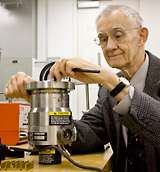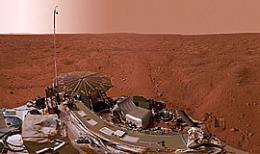Device reveals more about Mars' atmosphere

Instruments designed by a UT Dallas professor to measure atmospheric components on the surface of Mars have uncovered important clues about the planet’s atmosphere and climate history.
The findings, published in a recent issue of the journal Science, reveal how carbon dioxide isotopes have reacted to volcanic activity, water and weathering – thus forming a more complete picture of the current Martian atmosphere.
The NASA mission in which this work was accomplished was the Phoenix Lander, an unmanned spacecraft deployed to Mars in 2008.
UT Dallas �鶹��Ժics Professor John Hoffman, a member of the William B. Hanson Center for Space Sciences, designed the mass spectrometer through which soil samples collected at the surface of Mars were analyzed.
Samples of atmospheric gasses were drawn into the instrument during several Martian days, called “sols,” and analyzed to determine the type of gases that comprise the atmosphere.
“The dominant gas is carbon dioxide,” Hoffman said. “We examined these carbon dioxide molecules and measured the ratio of the light to heavy atoms of carbon and oxygen.”
Different mass atoms of an element are called isotopes. By contrasting these isotopes, Hoffman and other researchers could see how the gases were affected by geologic processes on Mars. Previous samples from the Martian atmosphere were analyzed three decades ago during NASA’s Viking program. The precision of those measurements was limited by the technology available at the time.
“The accuracy of the current measurements far surpasses the previous information we had,” Hoffman said. “Obviously, these geologic and atmospheric changes are slow processes, but we now have a better idea of the earlier planetary atmosphere.”

Scientists have also studied material from Martian meteorites that have landed on Earth. These data have helped fill in the time scale for the evolution of the atmosphere on Mars.
“These findings are exciting because they show how the atmosphere of Mars evolved and we can contrast that to our own history here on Earth,” Hoffman added. “We have a more complete understanding of our neighboring planet.”
Provided by University of Texas at Dallas




















